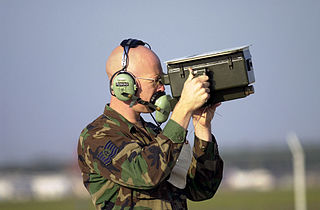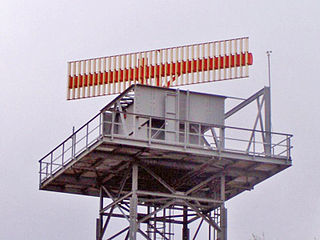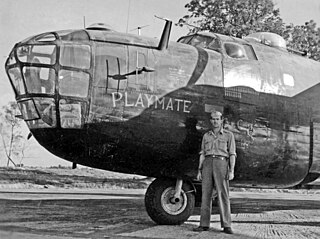
In telecommunications, a transponder is a device that, upon receiving a signal, emits a different signal in response. The term is a blend of transmitter and responder.

Identification, friend or foe (IFF) is an identification system designed for command and control. It uses a transponder that listens for an interrogation signal and then sends a response that identifies the broadcaster. IFF systems usually use radar frequencies, but other electromagnetic frequencies, radio or infrared, may be used. It enables military and civilian air traffic control interrogation systems to identify aircraft, vehicles or forces as friendly, as opposed to neutral or hostile, and to determine their bearing and range from the interrogator. IFF is used by both military and civilian aircraft. IFF was first developed during World War II, with the arrival of radar, and several friendly fire incidents.

In aviation, distance measuring equipment (DME) is a radio navigation technology that measures the slant range (distance) between an aircraft and a ground station by timing the propagation delay of radio signals in the frequency band between 960 and 1215 megahertz (MHz). Line-of-visibility between the aircraft and ground station is required. An interrogator (airborne) initiates an exchange by transmitting a pulse pair, on an assigned 'channel', to the transponder ground station. The channel assignment specifies the carrier frequency and the spacing between the pulses. After a known delay, the transponder replies by transmitting a pulse pair on a frequency that is offset from the interrogation frequency by 63 MHz and having specified separation.

A traffic collision avoidance system, also known as a traffic alert and collision avoidance system, is an aircraft collision avoidance system designed to reduce the incidence of mid-air collision (MAC) between aircraft. It monitors the airspace around an aircraft for other aircraft equipped with a corresponding active transponder, independent of air traffic control, and warns pilots of the presence of other transponder-equipped aircraft which may present a threat of MAC. It is a type of airborne collision avoidance system mandated by the International Civil Aviation Organization to be fitted to all aircraft with a maximum take-off mass (MTOM) of over 5,700 kg (12,600 lb) or authorized to carry more than 19 passengers. CFR 14, Ch I, part 135 requires that TCAS I be installed for aircraft with 10-30 passengers and TCAS II for aircraft with more than 30 passengers. ACAS/TCAS is based on secondary surveillance radar (SSR) transponder signals, but operates independently of ground-based equipment to provide advice to the pilot on potentially conflicting aircraft.

Secondary surveillance radar (SSR) is a radar system used in air traffic control (ATC), that unlike primary radar systems that measure the bearing and distance of targets using the detected reflections of radio signals, relies on targets equipped with a radar transponder, that reply to each interrogation signal by transmitting encoded data such as an identity code, the aircraft's altitude and further information depending on its chosen mode. SSR is based on the military identification friend or foe (IFF) technology originally developed during World War II, therefore the two systems are still compatible. Monopulse secondary surveillance radar (MSSR), Mode S, TCAS and ADS-B are similar modern methods of secondary surveillance.
The air traffic control radar beacon system (ATCRBS) is a system used in air traffic control (ATC) to enhance surveillance radar monitoring and separation of air traffic. It consists of a rotating ground antenna and transponders in aircraft. The ground antenna sweeps a narrow vertical beam of microwaves around the airspace. When the beam strikes an aircraft, the transponder transmits a return signal back giving information such as altitude and the Squawk Code, a four digit code assigned to each aircraft that enters a region. Information about this aircraft is then entered into the system and subsequently added to the controller's screen to display this information when queried. This information can include flight number designation and altitude of the aircraft. ATCRBS assists air traffic control (ATC) surveillance radars by acquiring information about the aircraft being monitored, and providing this information to the radar controllers. The controllers can use the information to identify radar returns from aircraft and to distinguish those returns from ground clutter.

An airborne collision avoidance system operates independently of ground-based equipment and air traffic control in warning pilots of the presence of other aircraft that may present a threat of collision. If the risk of collision is imminent, the system recommends a maneuver that will reduce the risk of collision. ACAS standards and recommended practices are mainly defined in annex 10, volume IV, of the Convention on International Civil Aviation. Much of the technology being applied to both military and general aviation today has been undergoing development by NASA and other partners since the 1980s.

A transponder landing system (TLS) is an all-weather, precision landing system that uses existing airborne transponder and instrument landing system (ILS) equipment to create a precision approach at a location where an ILS would normally not be available.

An airport surveillance radar (ASR) is a radar system used at airports to detect and display the presence and position of aircraft in the terminal area, the airspace around airports. It is the main air traffic control system for the airspace around airports. At large airports it typically controls traffic within a radius of 60 miles (96 km) of the airport below an elevation of 25,000 feet. The sophisticated systems at large airports consist of two different radar systems, the primary and secondary surveillance radar. The primary radar typically consists of a large rotating parabolic antenna dish that sweeps a vertical fan-shaped beam of microwaves around the airspace surrounding the airport. It detects the position and range of aircraft by microwaves reflected back to the antenna from the aircraft's surface. The secondary surveillance radar consists of a second rotating antenna, often mounted on the primary antenna, which interrogates the transponders of aircraft, which transmits a radio signal back containing the aircraft's identification, barometric altitude, and an emergency status code, which is displayed on the radar screen next to the return from the primary radar.

The Rebecca/Eureka transponding radar was a short-range radio navigation system used for the dropping of airborne forces and their supplies. It consisted of two parts, the Rebecca airborne transceiver and antenna system, and the Eureka ground-based transponder. Rebecca calculated the range to the Eureka based on the timing of the return signals, and its relative position using a highly directional antenna. The 'Rebecca' name comes from the phrase "Recognition of beacons". The 'Eureka' name comes from the Greek word meaning "I have found it!".

FLARM is a proprietary electronic system used to selectively alert pilots to potential collisions between aircraft. It is not formally an implementation of ADS-B, as it is optimized for the specific needs of light aircraft, not for long-range communication or ATC interaction. FLARM is a portmanteau of "flight" and "alarm". The installation of all physical FLARM devices is approved as a “Standard Change”, and the PowerFLARM Core specifically as a “Minor Change” by the European Aviation Safety Agency.; and in addition the Minor Change also approves the PowerFLARM Core for its IFR and at night.

Gol Transportes Aéreos Flight 1907 was a scheduled domestic passenger flight from Manaus, Brazil, to Brasília and Rio de Janeiro. On 29 September 2006, the Boeing 737-800 operating the flight collided with an Embraer Legacy 600 business jet over the Brazilian state of Mato Grosso. The winglet-equipped wingtip of the Legacy sliced off about half of the 737's left wing, causing the 737 to break up in midair and crash into an area of dense jungle, killing all 154 passengers and crew. Despite sustaining serious damage to its left wing and tail, the Legacy landed with its seven occupants uninjured.
In aviation, a mid-air collision is an accident in which two or more aircraft come into unplanned contact during flight. Owing to the relatively high velocities involved and the likelihood of subsequent impact with the ground or sea, very severe damage or the total destruction of at least one of the aircraft usually results.

A transponder is an electronic device that produces a response when it receives a radio-frequency interrogation. Aircraft have transponders to assist in identifying them on air traffic control radar. Collision avoidance systems have been developed to use transponder transmissions as a means of detecting aircraft at risk of colliding with each other.
Automatic Independent Surveillance – Privacy (AIS-P) is a data packet protocol for the TailLight system of aircraft Traffic Collision Avoidance System (TCAS), wherein a single Mode S 64 microsecond message is transmitted by an aircraft ATCRBS or Mode S transponder, and received by aircraft and Air Traffic Control on the ground. This is an augmentation to aircraft transponders, which report aircraft position and velocity in such a way as to minimize interference with any other avionics system, maximize the possible number of participating aircraft, while not relying on any equipment on the ground, and protecting aircraft from potential attack. AIS-P and ADS-B are competing protocols for aircraft based surveillance of traffic, a replacement technology for Mode S radar and TCAS.
Squitter refers to random pulses, pulse-pairs and other non-solicited messages used in various aviation radio systems' signal maintenance. Squitter pulses were originally, and are still, used in the DME/TACAN air navigation systems. Squitter pulses, because of their randomness and identical appearance to standard reply pulse-pairs, appear the same as unsolicited/unsynchronised replies to other interrogating aircraft.
The aviation transponder interrogation modes are the standard formats of pulsed sequences from an interrogating Secondary Surveillance Radar (SSR) or similar Automatic Dependent Surveillance-Broadcast (ADS-B) system. The reply format is usually referred to as a "code" from a transponder, which is used to determine detailed information from a suitably equipped aircraft.

Automatic Dependent Surveillance–Broadcast (ADS-B) is a surveillance technology and form of Electronic Conspicuity in which an aircraft determines its position via satellite navigation or other sensors and periodically broadcasts it, enabling it to be tracked. The information can be received by air traffic control ground stations as a replacement for secondary surveillance radar, as no interrogation signal is needed from the ground. It can also be transmitted and received point-to-point by other aircraft to provide situational awareness and allow self-separation. ADS-B is "automatic" in that it requires no pilot or external input. It is "dependent" in that it depends on data from the aircraft's navigation system.
Traffic information service – broadcast (TIS–B) is an aviation information service that allows pilots to see aircraft that are not emitting ADS-B data but have a basic transponder.
IFF Mark X was the NATO standard military identification friend or foe transponder system from the early 1950s until it was slowly replaced by the IFF Mark XII in the 1970s. It was also adopted by ICAO, with some modifications, as the civilian air traffic control (ATC) secondary radar (SSR) transponder. The X in the name does not mean "tenth", but "eXperimental". Later IFF models acted as if it was the tenth in the series and used subsequent numbers.
















